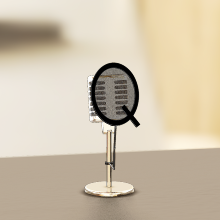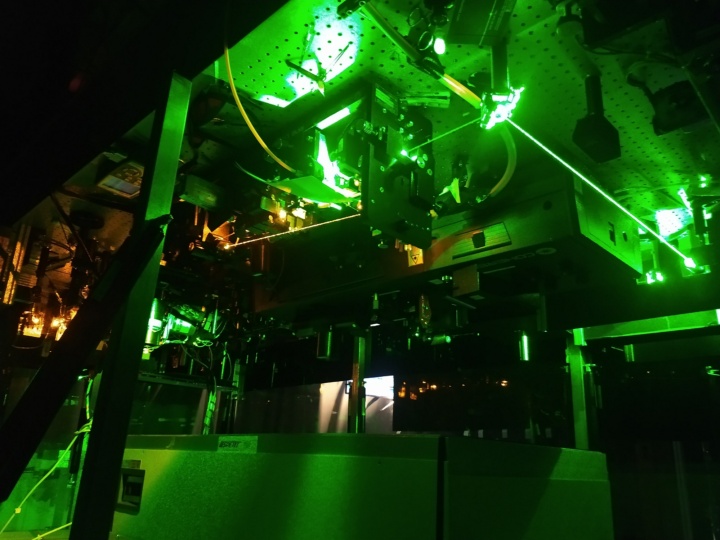Whether it's an online conference or a hearing aid, a high noise level in the microphones used, or significant background noise will disrupt any conversation, and better microphones are urgently needed. Researchers at the University of Stuttgart have now developed a quantum microphone that takes noise reduction to a whole new dimension. It was tested at Stuttgart's Olgahospital - with promising results.
So far, the development of commercially available microphones has focused primarily on suppressing technical noise sources, such as signal amplification electronics. A research group led by Dr. Florian Kaiser at the Institute of Physics 3 at the University of Stuttgart has now gone one step further and investigated the fundamental limit up to which noise can be suppressed. They were able to show that using quantum technologies can push these limits. To this end, the group first developed a laser microphone similar to those used for monitoring industrial machinery and in espionage. However, as expected, this classical laser microphone was limited in its performance capability by electrical noise present during the measurement process. In the next step, the classical laser light was replaced by specially-adapted quantum light, which directly improved the signal-to-noise ratio by 0.57 decibels. This might not seem like a lot at first glance. However, it is a significant improvement in low signal-to-noise environments, such as those commonly found in the communication between flight controllers and airplane pilots.
People can hear the advantage of quantum technologies for the first time
To conduct the measurements, researchers teamed up with the Olgahospital in Stuttgart to conduct a medically-approved speech recognition trial on 45 subjects. The aim of the study was to determine the minimum required sound level, above which patients correctly understood 50 percent of the words. The study found that more than 71% of the subjects were able to immediately recognize the improvement provided by the quantum microphone.
“These results are mainly based on the high rate at which we generate entangled photons, as well as the subsequent quantum state conversion from a multi-photon state to a single-photon state," explains project coordinator Dr. Florian Kaiser from the 3rd Institute of Physics at the University of Stuttgart. "The resulting increase in measurement rates by a factor of 10,000 compared to previous approaches enabled us to increase measurement rates up to 100 kHz, which allowed us to comfortably cover the audio band (20 Hz - 20 kHz). Additionally, thanks to the quantum state conversion, we can now use the same cost-effective detectors that we use for the classical laser microphone. This is or course very interesting from a commercial perspective."
Doctoral researcher Raphael Nold adds: “Our approach is not limited to use in quantum microphones. We also see great potential for our technology in imaging examinations of light-sensitive biospecimens. Our current work already clearly demonstrates that competitive quantum imaging is possible with commercially available enhancements." Dr. María T. Pérez Zaballos, who brought the experience she gained whilst writing her doctoral thesis at the University in Las Palmas / Spain (reviewer Florian Kaiser) to the research, adds: "My doctoral thesis concentrated on psychoacoustic experiments with air traffic controllers as well as people with hearing impairments. For me, this interdisciplinary research gives a glimpse of the medical technology innovations we will be able to enjoy in 50 years."
The aim: To integrate the system on a photonic chip
Although the commercialization of this approach is still a long way off, due to the high energy consumption required to generate the quantum light, the concept of quantum state conversion before light detection has the potential to become a game changer for future research studies. "Our next steps will involve benefiting from the tremendous advancements made in integrated quantum photonics to implement the entire setup on a photonic chip," says D. Florian Kaiser. "Having such compact systems at hand would enable a plethora of applications, covering fundamental research, bio-imaging, to effective public exhibitions and experiments in which people can directly experience quantum technologies."
Expert Contact:
Dr. Florian Kaiser, University of Stuttgart, Institute of Physics 3, Phone +49 711 685 60084, E-Mail
Original publication
Raphael Nold, Charles Babin, Joel Schmidt, Tobias Linkewitz, María T. Pérez Zaballos, Rainer Stöhr, Roman Kolesov, Vadim Vorobyov, Daniil M. Lukin, Rüdiger Boppert, Stefanie Barz, Jelena Vuckovic, J. Christof M. Gebhardt, Florian Kaiser, Jörg Wrachtrup: Quantum Optical Microphone in the Audio Band, in: PRX Quantum, publication on June 17, 2022, https://doi.org/10.1103/PRXQuantum.3.020358



